We've been running the drift fences surveys since the beginning of May, which has resulted in many excellent captures (one of which is below).
Yet, we also see cool stuff while we are walking out to our fences. For example, there's an old gnarled tree that overhangs the creek near one of our fences. Every day there are multiple Northern Watersnakes (Nerodia sipedon) hanging on the branches catching some rays.
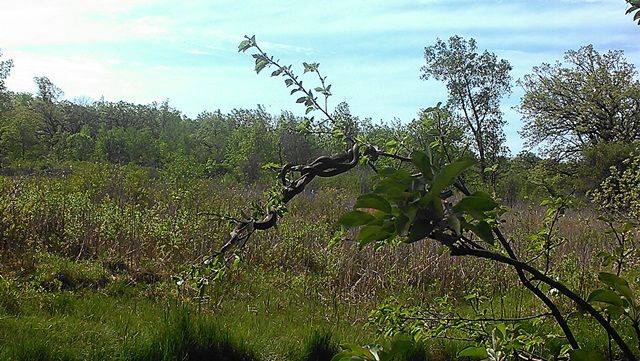 |
| Photo by N. Rudolph |
They never really appreciate my grabbing them...and the result is usually a bit of drawn blood (as you can see on my hand below). The bite looks much worse than it is, however. They are non-venomous, and their teeth feel like nothing more than tiny pin-pricks.
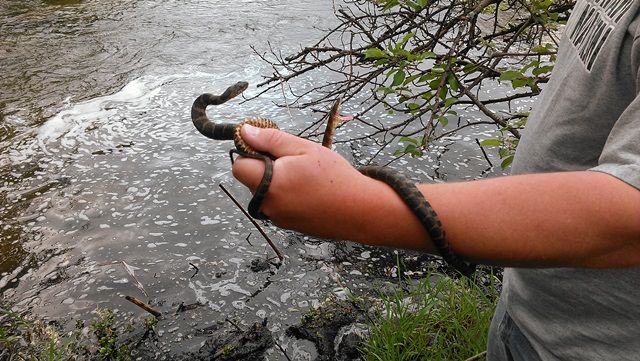 |
| Photo by N. Rudolph |
The poor watersnake frequently suffers greatly at the hands of humans. When the average person sees a snake near the water with a body pattern that is NOT similar to a gartersnake, they often think: "cottonmouth!" or "water moccasin!" and the snake is killed. There are NO cottonmouths or moccasins in the upper Midwest, unless one inlcudes southern Illinois (and I don't think they do?).
Amazingly, folks often argue with me about this! Here are example responses I get to telling them it wasn't a cottonmouth they saw: "Nope, I saw a cottonmouth on that canoe trip. There's nothing else it could have been." ...or..... "Well, I'm pretty sure that it was a moccasin that swam along the bank next to me while I was fishing."
But, let me re-iterate: the snakes in my hand above are NOT cottonmouths/moccasins! We do not have said venomous species 'round these parts.
BUT....none of this is even the point of my current post! So, I'll get on with it....
_________________________________________________________________________
The Beaten Bear:
Below is an impressive and "battle worn" Black Bear (Ursus americanus) that the wolf researchers captured on one of the camera traps.
Take a look at the lip on the left side of his face (right at the beginning of the clip). It looks to be torn....and his ears have clearly seen better days. He must be a wily sort to have avoided the hunters all these years.
I wonder whom he had a run-in with to have acquired all of that damage? Males compete for breeding rights, and perhaps his
I love a natural history mystery!
________________________________________________________________________
Poor Ol' Slim:
Poor Slim.....the unfortunate Short-tailed Weasel (Mustela erminea) that I found dead on the road not far from my house. I caught a glimpse of it while my daughter and I were driving home one day....and I thought it looked like a weasel, so we had to turn around so I could pull over and snap a picture (it wasn't in good enough condition to turn into much of a specimen).
Slim is either a juvenile Long-Tailed Weasel (Mustela frenata) or an adult Short-Tailed Weasel (M. erminea), based on the size and the black tip on the tail. The other weasel in our state...the Least Weasel (M. nivalis) has no black tail tip.
Adult Long-Tailed Weasels attain average sizes (13-16 inches) and this individual is not that large. Yet, this could be a juvenile Long-tailed Weasel....which would also make sense, seeing that the Long-Tailed Weasel is more common in the southern part of the state (where I am located) than the Short-tailed. But the tail on this specimen looks to be particularly short.
Hmmm.....
Another good mystery!
Fortunately, the summer hasn't been only negative encounters with weasels. Below are pictures of a little Least Weasel my students and I captured in a drift fence a few weeks ago (note the lack of black-tip on the tail). The drift fences are primarily for amphibians and reptiles, but we get just as many small mammals. In fact, the hidden secret of this herpetological technique: it's probably just as effective and less work day-in and day-out for small mammals as Sherman Traps. Although the fence takes alot of effort to install initially, there isn't the hassle of setting and re-baiting traps all the time. Plus, we get many intectivores (Shrews) and the occassional weasel, which Sherman Traps aren't effective at catching.
I imagine these little carnivores are attracted to the fence due to the smell of vole, which we catch many of. According to King and Powell (2007, The Natural History of Weasels and Stoats, Oxford University Press) the Least Weasel is the weasel that is the most narrow in its dietary preferences....eating almost exclusively on rodents and then focused primarily on voles (especially Microtus sp.). I've caught Least Weasels on several occassions in drift fences in years past, so I wasn't totally shocked. This is also not my first weasel post in the last year (see here).
But that doesn't mean I wasn't incredibly excited to see one! The Least Weasel, in particular, is rare 'round here....so it was quite a treat! Holding still is not the strong-suit of these frenetic little carnivores....so forgive the blurry pics (these were the best of about 30 attempts).
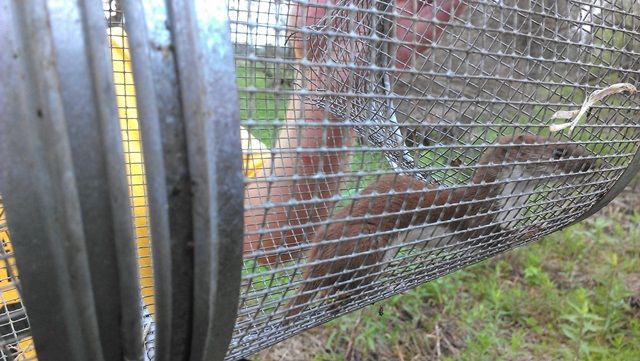 |
| Photo by N. Rudolph |
 |
| Photo by K. Rutzen |
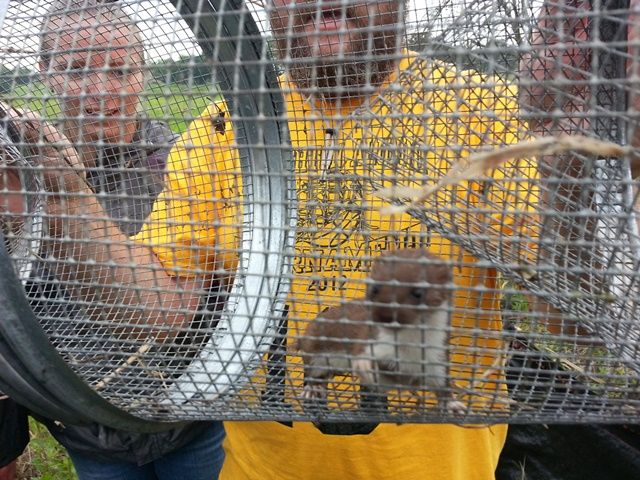 |
| Photo by K. Rutzen |
A Size-13 Snapper:
Mid-summer is when I often do most of my turtle trapping. As part of survey work this summer, I've been trapping in wetlands with the hopes of catching some Blanding's Turtles (Emydoidea blandingii). I've caught a few (as you can see)....
We also catch many, many Painted Turtles (Chrysemys picta)....
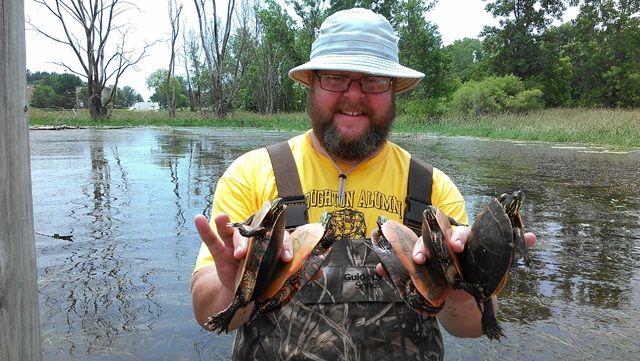 |
| Photo by N. Rudolph |
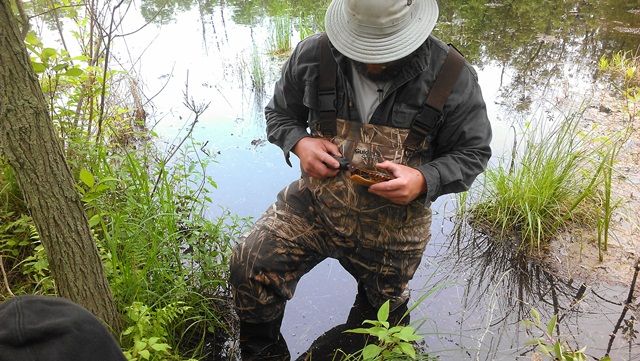 |
| Photo by N. Rudolph |
Regardless, the Northern Snapping Turtle is one of my favorite turtles: ornery, cantakerous, dirty, smelly, mean-looking.....everything I like in a critter :)
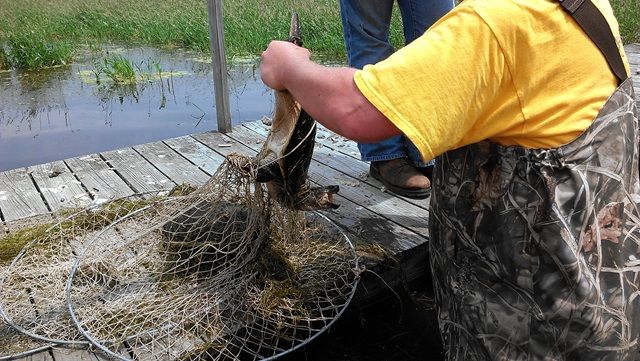 |
| Photo by N. Rudolph |
That prize belongs to the individual below. To put this into perspective, the boot on my chest-waders in this photo is a size 13.
It would be nice if more snapping turtles could make it to this size (or bigger).
I guess we have to start by getting folks to restrain from hitting them on purpose (I can't believe I had to actually say that).
Next we can try and come up with ways in which the average person can avoid hitting them on accident.
-sigh-




Wow! You've been busy. Interesting you caught a weasel in the trap.
ReplyDeleteThanks, Joe! Yeah...it's always a treat to catch the little guys. Hard to get good pictures, though! :)
ReplyDeleteWow! A lot going on lately! I've had all those same arguments about northern water snakes in my area. Frustrating sometimes. Poor bear and weasel:(. The least weasel is awesome too!
ReplyDeleteBill
One of my favorite of your postings! So much going on and all interesting.
ReplyDeleteThanks Brian!!
ReplyDeleteSomehow I missed this entry...and I'm doing some catch-up on lunch. I wonder if that bear had ear tags in? Both ears look notched to me, and if he had tags and they got ripped out...they could leave notches like that?
ReplyDeleteI've never seen a least weasel. In fact the one time I had a weasel in the hand (cat-killed), I don't remember making a definitive ID. I expected the least to be much smaller, but maybe the size is skewed because I don't have anything for size reference in that trap. The tail is stubby though!